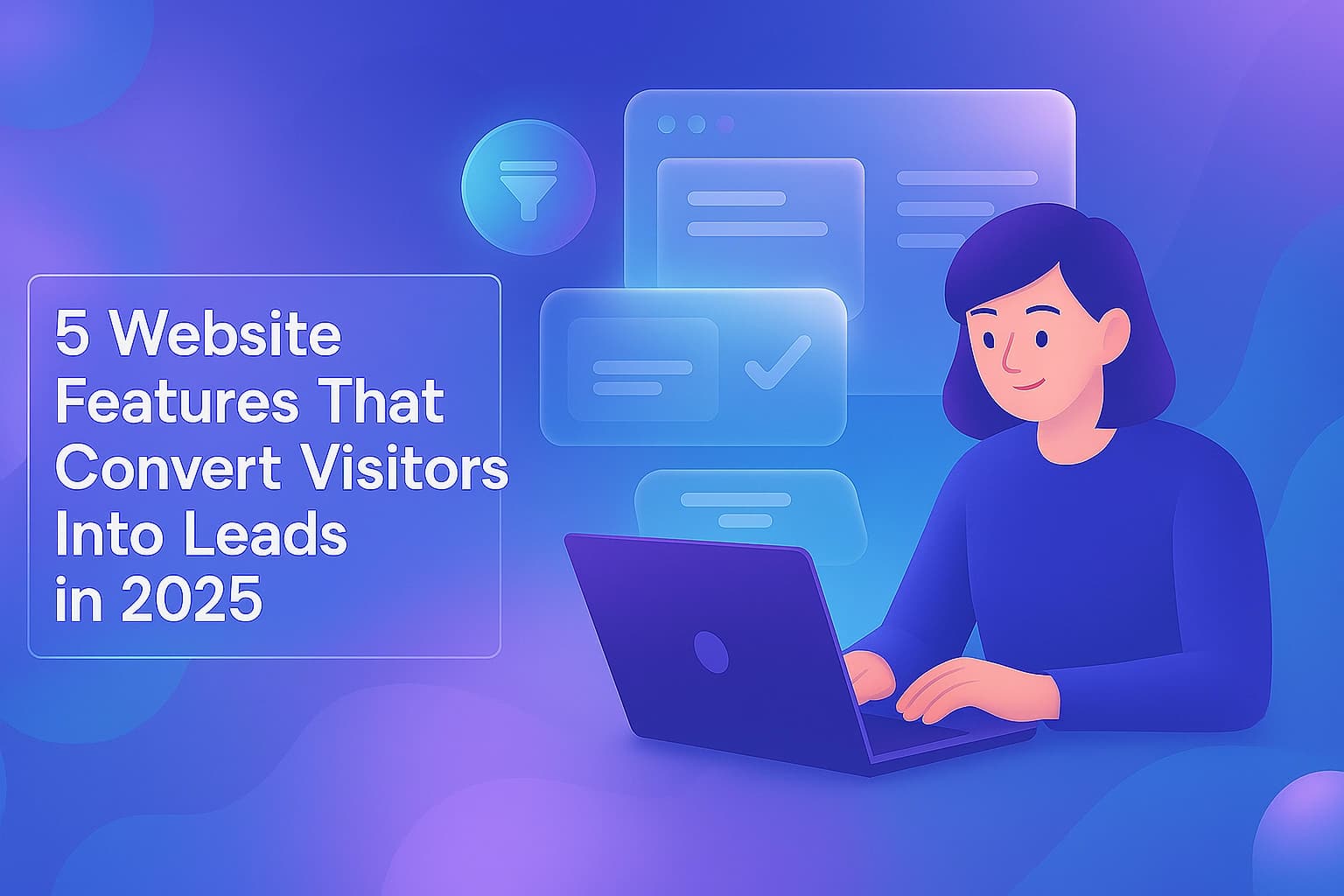5 Website Features That Convert Visitors Into Leads in 2025
Key website elements that boost engagement and drive more inquiries from your visitors

5 Website Features That Convert Visitors Into Leads in 2025
The digital landscape has evolved significantly, and so have user expectations. In 2025, turning website visitors into qualified leads requires a strategic approach focused on user experience, personalization, and clear value communication. Based on extensive conversion research, these five website features have emerged as the most effective for generating quality leads for web design agencies.
1. Interactive Portfolio Showcases
Static portfolio pages are becoming increasingly ineffective at converting visitors. Today's most successful agencies are implementing:
Interactive Case Study Explorers
Rather than simply displaying final results, high-converting portfolios in 2025:
- Allow visitors to toggle between "before" and "after" states of projects
- Include specific metrics and results achieved for each client
- Provide context about client challenges and how they were solved
- Segment portfolio items by industry, allowing prospects to find relevant examples
- Incorporate client testimonial videos discussing the transformation
Implementation Strategy: Create a filterable, interactive showcase where potential clients can explore projects relevant to their industry. Include documented improvements in key metrics like conversion rates, load times, or engagement statistics.
2. AI-Enhanced Chat Experiences
Basic chatbots have evolved into sophisticated conversation engines that qualify leads while delivering genuine value:
Modern Chat Implementations
The most effective chat features now:
- Answer industry-specific questions with detailed, relevant information
- Qualify visitors through conversational assessment rather than rigid forms
- Offer instant website audits by analyzing visitor's site in real-time
- Schedule meetings directly within the chat interface
- Seamlessly transition to human support when appropriate
Implementation Strategy: Implement a solution that combines automation with personalization. Focus on creating conversation flows that help visitors articulate their specific needs while educating them about your process and approach.
3. Personalized Content Paths
Generic, one-size-fits-all content rarely converts effectively. Leading agencies are now implementing:
Dynamic Content Experiences
These sophisticated content systems:
- Detect visitor industry or interests through behavior or direct questions
- Customize case studies and examples based on visitor profile
- Adjust messaging to focus on relevant pain points
- Offer industry-specific resources and insights
- Create "content journeys" that guide visitors toward conversion
Implementation Strategy: Implement a content personalization system that adapts based on user behavior, referral sources, or explicit choices. Create content variants for different industries and pain points.
4. Strategic Social Proof Integration
While testimonials have always been important, their implementation has evolved significantly:
Next-Generation Social Proof
High-converting websites now include:
- Results-focused testimonials with specific metrics and outcomes
- Industry-matched social proof shown to visitors based on their sector
- Process testimonials that address common prospect anxieties about working together
- Social proof progression that follows the visitor journey through the site
- Third-party verification through recognized platforms and certifications
Implementation Strategy: Collect and organize testimonials by industry, challenge type, and project size. Strategically place relevant testimonials at key decision points in the visitor journey rather than isolating them on a dedicated page.
5. Value-Forward Contact Systems
Traditional "contact us" forms are being replaced by value-exchange systems:
Modern Lead Capture Approaches
The most effective lead generation mechanisms now:
- Offer immediate value (site audit, resource, template) in exchange for contact information
- Use multi-step micro-commitments rather than intimidating forms
- Provide transparent next steps after submission
- Include qualifying questions that help prioritize leads
- Follow up with automated, personalized responses
Implementation Strategy: Replace generic contact forms with interactive processes that deliver immediate value to prospects while gathering qualification information. Focus on reducing friction while increasing the perceived value of taking the next step.
Implementation Guide: Beyond Features to Strategy
While these features are proven to increase conversions, implementation requires strategic consideration:
1. Prioritize Based on Your Target Client
Not all features will be equally effective for all agencies:
- Enterprise-focused agencies should emphasize robust case studies and social proof
- Small business specialists may benefit more from streamlined lead capture and clear pricing
- Niche industry experts should prioritize personalization and industry-specific content
2. Ensure Mobile Optimization
With over 60% of initial agency research happening on mobile devices in 2025:
- Test all conversion features on multiple devices
- Consider mobile-first implementation of key features
- Simplify mobile interactions while maintaining functionality
3. Measure What Matters
Implement analytics that track the effectiveness of each feature:
- Set up conversion funnels for each lead generation pathway
- Track quality of leads not just quantity
- A/B test variations of key features
- Monitor user engagement with interactive elements
Conclusion
Converting visitors into leads in 2025 requires moving beyond static website features to creating interactive, personalized experiences that demonstrate value and build trust. By strategically implementing these five key features—interactive portfolios, AI-enhanced chat, personalized content paths, strategic social proof, and value-forward contact systems—agencies can significantly increase both the quantity and quality of leads generated through their websites.
Remember that effective implementation requires ongoing testing and refinement. The most successful agencies treat their website as a constantly evolving system, regularly updating features based on user behavior and conversion data.

About Thijs van der Veer
CEO / Founder of Leadodo, passionate about helping web design agencies scale their business through innovative lead generation solutions.
Found this helpful?
Share this article with other web design agencies